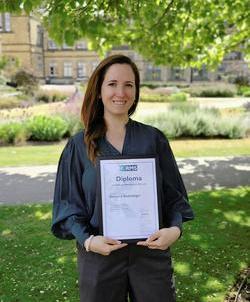
Ramona Szalczinger DipRMS
The Development of Teaching Materials for the Use of Scanning Electron Microscopy for Secondary School Education
"My study aimed to help lift practical scanning electron microscopy into secondary school education, and thus encourage STEM learning by providing teaching staff with teaching materials and lesson notes to match the national curriculum."
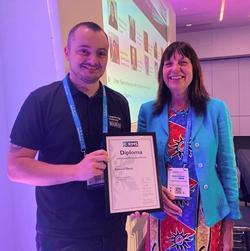
Samuel Davis DipRMS
Electron Microscopy Study of Precipitates in Energy Generation Steels
"Using a multimodal approach to compare precipitate imaging techniques of power generation steels. Both Scanning Electron and Focused Ion Beam (FIB) systems were used to collect images, employing a combination of modern detectors, and optimised operating parameters for each system. These were compared to benchmark examples cited in the literature with a view to improving upon the currently referenced standards."
Adam Costin DipRMS
Testing, optimising and implementing cryo-sample preparation and imaging techniques to optimise sample quality and acquisition efficiency in single particle analysis
"With the rise of cryo-EM as a powerful tool for solving protein structures there has been an influx of new researchers learning the technique. Sample optimisation for cryo-EM remains slow and highly inconsistent. This study aimed to create a workflow that will systematically optimise sample preparation much faster for new users. This was done through a comprehensive assessment of current techniques and then tested within the context of an EM Facility. A way of simply incorporating tomography into the process was also developed, as this is a powerful way of assessing ice thickness and protein structure."
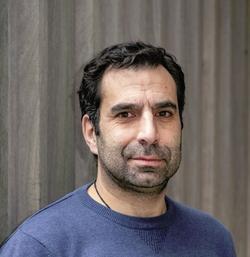
Alfonso Schmidt Mery DipRMS
Polychromatic Optimization Protocol for Three Dimensional Immune and Structural Characterization of Whole-Mount Skin
"Skin is the first line of defence and the immune system’s biggest barrier for combating pathogens. Being able to accurately characterize and identify immune cell subtypes and structures in the skin under steady-state conditions, might provide a powerful tool for understanding the first immunological strategies and biological processes that occur in presence of pathogens."
Craig Holliday DipRMS
Characterisation of the Migratory Properties of Additives used in Acrylic Coating on Polymer Film
"Polypropylene film is often coated with acrylic nano-particle formulations which contain migratory additives designed to modify the surface properties of the material. Whilst it is possible to quantify the levels using infra-red spectroscopy, this only provides a bulk assay.
It is hoped that a method to image the dried acrylic coating and map additive distributions on the dried surface can be developed to allow a study of the interaction of bulk levels and drying temperature on the migratory behaviour. This can then be correlated to physical and optical characteristics to optimise manufacturing conditions."
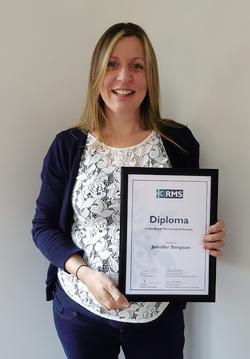
Jennifer Simpson DipRMS
The Study of Marek’s Disease Virus In Feather Follicle Epithelium
"Marek's disease virus (MDV) is an alphaherpesvirus which causes a lymphoproliferative disease in chickens. Infection occurs by inhalation of infected dander and following a complex life cycle involving infection of B and T cells, the virus is shed from the feather follicle. Vaccination is available and prevents clinical disease however it does not prevent the shedding of virus. The feather follicle is important in the transmission of MDV as the feather follicle epithelium (FFE) is the only region where fully enveloped and infectious virus particles are assembled. This study aimed to identify cell tropism and describe viral morphogenesis in the FFE using immunofluorescence and transmission electron microscopy."
Peter Eaton DipRMS
A Combined Microscopy Study of the Interactions of Nanoparticles with Cells
"The study focused on the interactions between a variety of nanoparticles, synthesized within the host group with eukaryotic and bacterial cells. Furthermore, skills were improved in a number of microscopy techniques, namely SEM imaging and EDS analysis, TEM imaging, EDS analysis and diffraction, and biological specimen preparation. The results will contribute to projects based on toxicology of nanoparticles to mammals and antibacterial properties on nanoparticles."
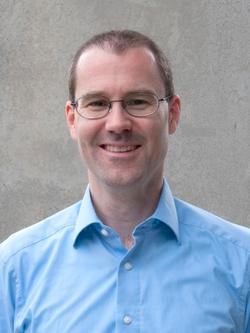
Pascal Lorentz DipRMS
Characterisation of phenotypes of neuroblastma cells targeted by siRNA using a high content screening microscope and its analysis software
"Neurite outgrowth as an important step during the nervous system development is still not completely understood. During my study I wanted to make use of a recently acquired high content screening microscope (Operetta, Perkin Elmer) to scan neuroblastma cells where different genes have been silenced using siRNA that are known to somehow influence the neurite outgrowth process. Afterwards I used the Columbus software from Perkin Elmer to characterise the different phenotypes and established an analysis process that will be of further use to many users."
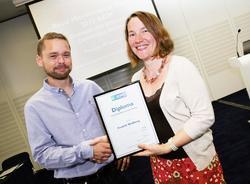
Fredrik Wallberg DipRMS
Lighting up necroptosis and other types of cell death
"Necroptosis is a novel programed cell death pathway relevant for tumour cell responses to chemotherapeutic agents. In a recent study (Tenev et al., 2011), I developed a time-lapse video microscopy protocol using annexin V, PI and morphology to monitor necroptosis. In my diploma work I extended these methodologies as a tool to analyse different types of cell death but with an emphasis on necroptosis. Once I have established a combination of dyes and fluorescent proteins that can distinguish several types of cell death I aim to utilise these to establish a screening platform for cell death."
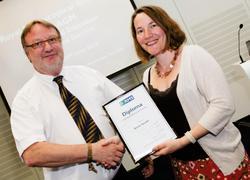
Kevin Smith DipRMS
The role of Microscopy in the Preparation and Evaluation of Metallographically Prepared Materials
"It is intended within the course of this work, to determine how microscopy can be used to aid in the preparation of materials for microstructural analysis. Not only will it look at the range of techniques to obtain the information from the fully prepared sample but will show how operators can use various aspects of microscopy to understand and develop sound technical procedures for the processes leading to that finished sample. Understanding these principles will allow metallographers to understand and employ best practice to prepare specimens correctly for later microstructural assessment."
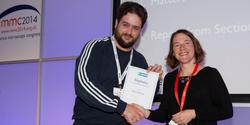
Peter Pitrone DipRMS
Building a Selective Plane Illumination Microscope System on a Limited Budget
"The traditional light microscope has advanced our understanding of living systems in the last few centuries by its ability to reveal the microscopic world to us. Novel microscopy technologies allow us to monitor these living systems with ever increasing resolution in both spatial and temporal dimensions. In particular, the Selective Plane Illumination Microscopy (SPIM) promises to revolutionize research in developmental biology by capturing entire embryos with cellular resolution. My plan is to build a SPIM system on a limited budget without sacrificing its key benefits and thus make the technology available to a broad scientific community."
For myself it was a useful and rewarding experience. It has been a long time since I had carried out any detailed research and I did enjoy the investigative process. I had an aim but I wasn't actually sure where it would take me until I progressed through it. Applying the various techniques to investigate particular aspects which I understood or believed gave me further understanding of what is happening during materials preparation.
Now having this material I can use it for the training I do for Materials Preparation & Microscopy. I run these courses regularly for MetPrep and to have had the time to generate this additional data to highlight certain aspects was great. It gives those coming into the area of Materials Preparation & Materials Microscopy something to really latch on to & creates a better understanding.
